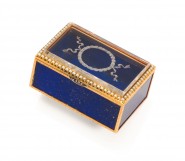Lot #7 - Charles Conder
-
Auction House:Mossgreen
-
Sale Name:The Alan & Margaret Hickinbotham Collection
-
Sale Date:25 Jun 2017 ~ 2pm (Australian Central Standard Time)
-
Lot #:7
-
Lot Description:Charles Conder
(1868-1909)
(Springtime, Arques-la-Bataille), (1899)
oil on canvas
58.5 x 71cm
bears William Derby Gallery, New Bond Street London label verso -
Provenance:The artist; L. F. Harrison Esq., acquired from the above; Thence by descent; Michael Harrison, 1966; G. J. Shipley; T. Hobson, 1975; William Darby, London; Sir Leon and Lady Trout, Brisbane; The Collection of Sir Leon and Lady Trout, Christie’s, Brisbane, 6 June 1989, lot 179, as ‘Springtime’, (illustrated)
-
Exhibited:Ten English Impressionist Paintings (1884-1919), William Darby, London, 2–19 April 1974, cat. no. 1 (label verso); Master Works from the Collection of Sir Leon and Lady Trout, Queensland Art Gallery, Brisbane, 21 September – 21 November 1977, cat. no. 6; Gifts from the Collection of Sir Leon and Lady Trout, Queensland Art Gallery, 27 January – 20 March 1984, Brisbane, 1984, cat. no. 19
-
References:The English Impressionist Paintings (1884-1919), William Darby, London, 1974, (illustrated), (unpaged); Bettina MacAulay, Master Works from the Collection of Sir Leon and Lady Trout, Queensland Art Gallery, Brisbane, 1977, p. 7; Gifts from the Collection of Sir Leon and Lady Trout, Queensland Art Gallery, Brisbane, 1984
-
Notes:To the twenty-first century observer, it may be difficult to imagine that Charles Conder’s full biography, until recently, was consigned to obscurity. The ground-breaking research conducted by Ann Galbally two decades ago has restored a great deal of understanding of the artist’s life and work, particularly between the years 1890-1909 – the period following his departure from Australia, that in which in which the present work was produced. In fact, until Galbally’s publications of 2002-3, the majority of scholarship on Conder focused on his Australian period:1884-1890. His contribution to the development of Australian art was so great that the artist’s later work from England and France was almost totally ignored. In Australia, following his leading involvement with the legendary ‘9 by 5 Impression Exhibition, at just twenty years of age, he was considered a leader of Australian Impressionism.2 Despite the success d’estime, the lure of Paris was too strong. Conder left Australia to produce a tremendous body of work. In Europe, in his eternal search for la vie de bohème, he was welcomed into the circles of a number of key progressive Anglo-French artists and writers. He was close to Oscar Wilde, shared a studio with William Rothenstein, frequented Louis Anquetin, and maintained a life-long friendship with Toulouse Lautrec. The move to the Old Continent signalled Conder’s abandonment of Pleinairism, Impressionism and Symbolism in favour of a more elegant and aesthetic code, one which embodied a new international style – art nouveau. ‘Conder is more representative of the fin de siècle than any other English artist’ wrote David Rogers. ‘Alone among his contemporaries, he records the passing of life and an awareness that all in transitory.’3 Conder’s interest with the transitory nature of existence is demonstrated in his seasonal subjects. Spring blossoms were a favourite motif amongst the late nineteenth century artists, and Conder was no exception. He painted several primaveral works throughout this lifetime including Springtime, 1888, (National Gallery of Victoria, Melbourne) and Blossoms – an Apple Orchard in Brittany, c. 1902 (Art Gallery of New South Wales, Sydney). In the present work, the introduction of figures and cathedral are largely employed as staffage. The artist’s primary concern rests in the overwhelming dominance of nature. The presence of figures intensifies this majesty of nature. Framed by a series of whiplashing branches, and covered in an explosion of spring blossoms, the present work is a masterly example of the artist’s late, elegant French style. Until now, the date of the present work was only hypothesised, and its possible setting has never been suggested. With Conder’s nomadic nature, such details can be difficult to pin down with any degree of precision. In the 1890s, the artist was constantly moving between France and England. In 1899 alone, the year this work was produced, Conder is recorded to have shifted constantly between Paris, Provence, Dennement, London, Varretot-sur-mer, Pourville, Dieppe and Beauvais.4 He was travelling through Normandy with the author and poet Ernest Dowson. In April, they paused in the small hamlet of Arques-la-Bataille, near Dieppe. It was the middle of spring and Conder is recorded to have been painting at the time.5 A close examination of the church to the left of the composition positively identifies this work as a view of l’èglise Notre-Dame-de-l’Assomption d’Arques-la Bataaille. Conder probably exhibited the work, under another title, with Carfax Galleries in London or Paris in 1899 or 1900. The latter exhibition was received as a huge success. ‘Critics picked up on the eighteenth century ‘feel’ of his work,’ notes Ann Galbally, ‘drawing comparisons with Watteau. His use of colour was seen as ‘masterly’.6 (Springtime Arques-la-Bataille), 1899, has a strong provenance and exhibition history. It was one of the most important works in the collection of Sir Leon and Lady Trout and is without doubt, one of the best examples of Conder’s turn of the century oeuvre. Petrit Abazi 1 William Rothenstein, cited in David Rodgers, Charles Conder 1868-1909: paintings, watercolours, drawings, The Fine Art Society and The Piccadilly Gallery, 1969, (unpaginated); 2 Sophie Osmond, Table Talk, 28 June 1889; 3 David Rodgers, Charles Conder 1868-1909: paintings, watercolours, drawings, The Fine Art Society and The Piccadilly Gallery, 1969, (unpaginated); 4 Mary Eagle, The Oil Paintings of Charles Conder in the National Gallery of Australia, National Gallery of Australia, Canberra, 1997, p. 77; 5 Ann Galbally, Charles Conder: the last bohemian, The Miegunyah Press, Melbourne, 2002, p. 181; 6 Ibid., p. 202
-
Estimate:A$50,000 - 70,000
-
Realised Price:
-
Category:Art
This Sale has been held and this item is no longer available. Details are provided for information purposes only.










